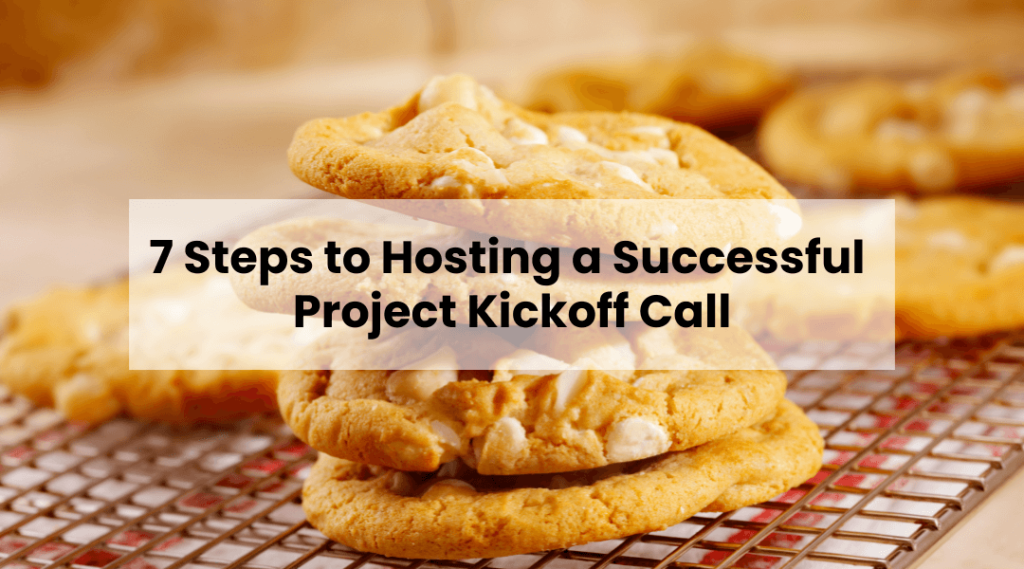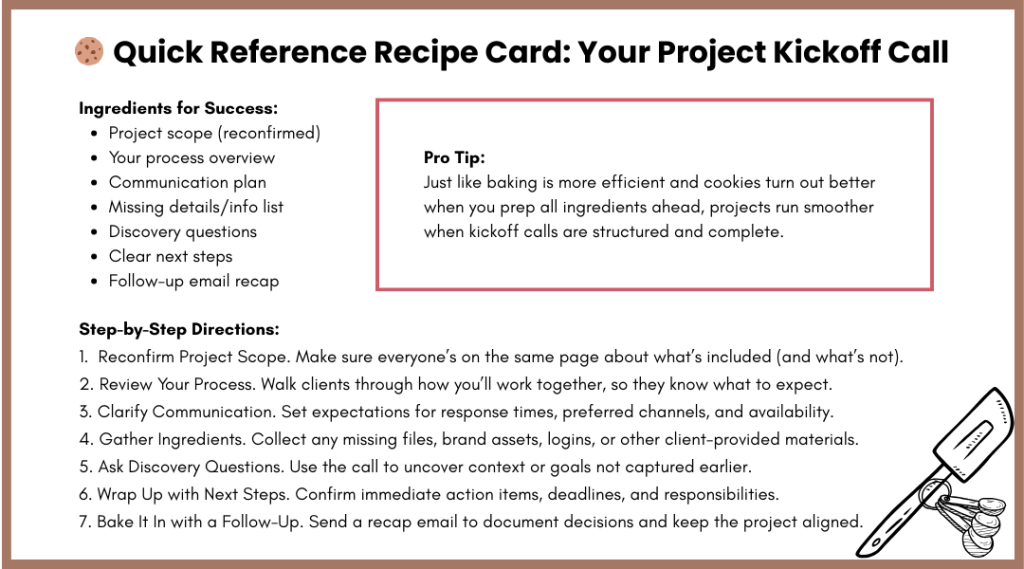The other day, I baked a batch of white chocolate chip macadamia nut cookies. They were delicious! A decadent delight!
There’s a lot I enjoy about baking, but one specific thing I like about it is how predictable the process is. You start with a clear recipe, gather all the ingredients, and follow specified steps that lead to something sweet and satisfying at the end.
And trust me, the end result turns out far better when you follow a tried-and-true recipe than if you attempt to wing it.
Project kickoff calls are the same. If you skip steps, forget a key ingredient, or assume you’ll figure it out as you go, things can get messy… fast.
But, if you follow a proven “recipe” for your kickoff calls, you set yourself — and your client — up for success.
And just like baking cookies feels easier when the flour, sugar, and butter are all measured out ahead of time, kickoff calls are smoother when you come prepared. You not only build trust, but also prevent one of the biggest frustrations in freelance projects — scope creep.
Here’s a 7-step “recipe” for hosting a project kickoff call that keeps everyone aligned and projects running smoothly.

Step 1: Reconfirm the Project Scope
Think of this as reading through the recipe before you turn on the oven.
Even if you and the client already agreed on the scope in your proposal or contract, restating it at the kickoff call ensures everyone’s on the same page. This is your chance to eliminate misunderstandings before they cause problems.
You might say something like this:
“Just to confirm, the project includes a 3-part email welcome series, with me providing the copy, two rounds of revisions, and delivery in Word format by October 15. Are we on the same page?”
Reconfirming scope sets clear boundaries and provides a natural segue into expectations.
Step 2: Review Your Process
When I bake cookies, I know the order matters — cream the butter and sugar first, then add eggs, then flour, and so on. Skipping steps changes the result.
Your clients need to understand your process, too. Walk them through how you’ll work together, step by step.
For example:
- How you’ll submit drafts
- When they’ll review and provide feedback
- What happens if edits exceed the agreed number of rounds
By reviewing your process, you eliminate surprises and reassure clients that you’ve done this before and have a clear plan.
Step 3: Clarify Communication Expectations
Just like deciding if you’re using parchment paper or a greased baking sheet, you need to agree on how you’ll communicate.
Ask your client how they prefer updates — by email, project management tool, or short Zoom check-ins. Then clarify response times on both sides.
Here’s an example:
“I typically respond to emails within 24 hours during weekdays. How quickly should I expect feedback from your side, once I send drafts?”
Clear expectations about communication prevent delays and avoid frustration later.
Step 4: Gather Any Missing Information
Have you ever started baking only to realize you’re out of vanilla extract? That one missing ingredient can stall the whole process while you run to the store to get it.
The same is true for client projects. Use the kickoff call to collect anything you don’t yet have but need — things like brand guidelines, buyer personas, product details, access to tools, etc.
A quick checklist before ending the call ensures you won’t be scrambling mid-project.
Step 5: Ask Discovery Questions Not Already Answered
Even with a recipe, you sometimes add a pinch of cinnamon or an extra handful of chips to make it your own.
Use the kickoff call to ask questions that help you add those “extra touches” to the project. These aren’t about the nuts and bolts of scope, but about context and goals. You may have already asked these during previous conversations, but if not, now’s the time.
Here are some examples:
- “What would success look like for you beyond the metrics?”
- “Are there any past campaigns you loved — or hated — that I should review?”
- “Who needs to sign off on copy before it goes live?”
These questions show you’re invested in the client’s success, not just checking boxes.
Step 6: Wrap Up with Next Steps
By now, the dough is mixed and ready to bake — but you don’t just leave it on the counter. You put it in the oven and set the timer.
Do the same with your kickoff call. Clearly state what happens next and who’s responsible.
For example:
- You’ll send the first draft by X date.
- The client will provide Y materials by Z date.
- You’ll check in when progress on the project hits a specific milestone.
This makes the client feel confident the project is in good hands.
Step 7: Follow Up with a Recap Email
After the cookies are out of the oven, you let them cool before enjoying them. That pause ensures they’re ready to eat.
The same goes for your kickoff call — it’s not truly done until you send a follow-up recap email.
Here are some things to include:
- Reconfirmed scope
- Key decisions made during the call
- Missing items the client promised to send
- Timeline and next steps
This recap becomes your reference point, if confusion arises later — and it keeps scope creep at bay.

Your Recipe for Success
A project kickoff call isn’t just about logistics. It’s about building trust, creating alignment, and demonstrating leadership.
When you show up prepared — recipe in hand, ingredients ready, process clear — you set the tone for a smooth and successful project. Clients see you as a pro they can rely on, not just a writer they hired.
And, just like those white chocolate chip macadamia nut cookies, the result is worth the effort. Everyone enjoys the process more, and the finished product turns out just right.
🍪 Quick Reference Recipe Card: Your Project Kickoff Call
(Keep this “recipe” handy so you don’t miss a step!)
Ingredients for Success:
- Project scope (reconfirmed)
- Your process overview
- Communication plan
- Missing details/info list
- Discovery questions
- Clear next steps
- Follow-up email recap
Step-by-Step Directions:
- Reconfirm Project Scope. Make sure everyone’s on the same page about what’s included (and what’s not).
- Review Your Process. Walk clients through how you’ll work together, so they know what to expect.
- Clarify Communication. Set expectations for response times, preferred channels, and availability.
- Gather Ingredients. Collect any missing files, brand assets, logins, or other client-provided materials.
- Ask Discovery Questions. Use the call to uncover context or goals not captured earlier.
- Wrap Up with Next Steps. Confirm immediate action items, deadlines, and responsibilities.
- Bake It In with a Follow-Up. Send a recap email to document decisions and keep the project aligned.
Pro Tip: Just like cookies turn out better when you prep all ingredients ahead, projects run smoother when kickoff calls are structured and complete.
